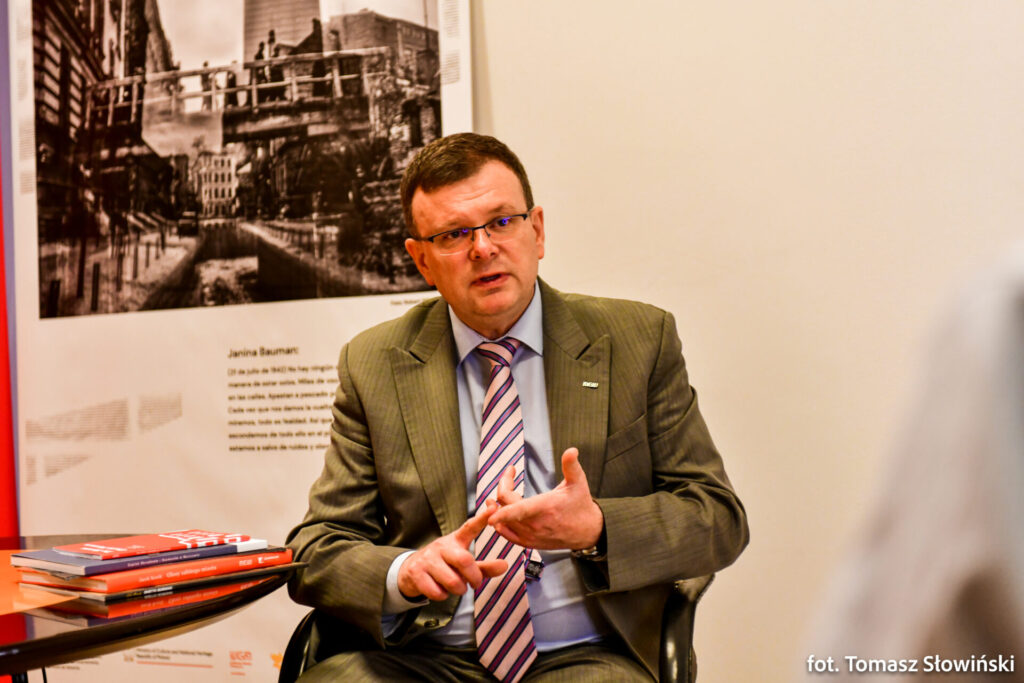Spanish Media and The Warsaw Ghetto Museum
WGM Director Albert Stankowski’s recent visit to Madrid drew much interest in Spanish mass media. Interviews from Mr. Stankowski’s interviews appeared across the Spanish press and described the Museum’s permanent exhibition, which may appeal to a wide spectrum of the Spanish population.
Stankowski presented the concept of the permanent exhibition in his interview with the EFE news agency. He explained that the first gallery will be dedicated to the Jewish history of Warsaw from the end of the 19th century through 1939. Other galleries will speak about the Warsaw Ghetto history and the genesis of the Jewish resistance. He added that there will be a gallery about genocides in different parts of the world beyond Poland.
“Totalitarianism always starts with a limitation of civil rights which becomes more and more restrictive over time,” he underlined, adding that a civic society plays a special role in stopping totalitarianism, which of course did not occur in pre-World War II in Europe.

In his interview for El Debate, Stankowski discussed the Museum opening not before 2026: „It is worth remembering that a hospital was functioning in the building of the former Bersohn and Bauman Hospital, our future seat up to 2017. The building, erected in 1878, is in need of major modernization – for example, it’s not accessible for disabled persons right now. All this is a very expensive undertaking.”
He continued: Originally the building was supposed to be demolished, and a skyscraper built on the site – the location, in the very center of Warsaw, five minutes from the Central Railway Station, is very attractive. Luckily, the city didn’t accept that. The building soon became a part of the register of monuments and, starting from that moment, nobody was interested in demolishing it. The former hospital had begun to deteriorate, and the Ministry of Culture decided to buy it. However, part of the land belonged to private owners, so all this took quite a while.”
Stankowski explained where the Museum exhibits come from:
“The objects derive from purchases, loans and donations. For example, I spent five years looking for a cannon used in the Warsaw Ghetto uprising. I had a picture of it that you can see in “The Pianist” movie”. I finally found a private Swiss collector who had it. “ He noted, “The pieces come from all over the world. Sometimes it is very hard to convince institutions to make a donation or loan. For example, it has been difficult to obtain the Stroop Report on its destruction, which is going to be one of the Museum’s most important pieces. Or the wheelbarrow used to move the dead from the ghetto: there is only one copy remaining.”
He also added that the Museum will concentrate on “physical” objects: “Interactive exhibitions are popular, but real objects have real power”. He further underlined the importance of the testimonies of the Holocaust survivors: “It is hard to imagine how several million people can be killed in such a short time period. One generation knew about it, but the next ones might have a problem in understanding it. That is why it is so important to use oral testimonies of the Holocaust witnesses.”
Spanish media has also mentioned the vernissage of the local photography exhibition of the WGM „City of the Living / City of the Dead ”. The ambassador of Poland to Spain Anna Sroka and the ambassador of Israel to Spain Rodica Radian-Gordon were present at the exhibition opening. “Holocaust has always been a warning against the danger of hatred, lack of tolerance, racism and prejudices,” the Israeli ambassador noted.
Albert Stankowski visited the Spanish capital at the invitation of the Polish Institute Madrid Gabierla Słowińska.
The exhibition „City of the Living / City of the Dead” – the photographic project of Robert Wilczyński combining the photos of modern Warsaw and the photographs from the archives – can be seen in Madrid till May 25, 2023.

